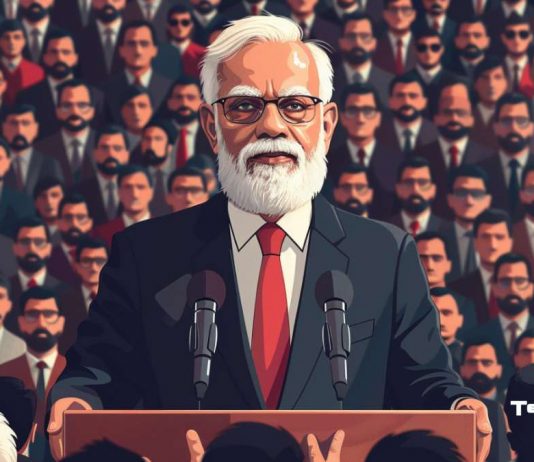- Deepfakes are manipulating voter opinions and damaging opponents’ reputations in Indian elections.
- Deepfakes enable personalized political messages in multiple languages, effectively reaching and influencing voters, especially in remote areas.
- The use of deepfakes raises ethical issues and threatens the integrity of democracy, with the potential for increased manipulation as technology advances.
Deepfakes are videos or audios created using artificial intelligence that mimic reality so accurately that they can easily deceive people. Initially, deepfakes were mainly used for entertainment, like putting Jim Carrey’s face on Jack Nicholson’s character in The Shining or having Nicolas Cage play all the characters in Friends simultaneously. While these uses are humorous, as the technology advances, it is increasingly being used for more dubious purposes.
In 2018, a viral video showed Barack Obama’s face superimposed onto actor Jordan Peele. In this video, Peele delivered absurd statements to illustrate how deepfakes could be used to manipulate voters during elections. Since then, the production of these videos has advanced significantly. For example, Kendrick Lamar’s 2022 music video showcased the rapper seamlessly transforming into various figures like Will Smith, Kobe Bryant, and Kanye West. The level of realism has increased dramatically in just a few years.
These technological advances are both impressive and alarming, as they lead us to a point where we can no longer trust what we see with our own eyes. Today, we can already see the potential of deepfakes to influence elections, particularly in the world’s largest democracy, India. In India, political parties have started producing fake videos where it seems like a famous actor is criticizing the current Prime Minister, Narendra Modi, and urging people to vote for opposition parties. This situation makes it increasingly challenging to make well-informed political decisions.
Deepfakes Disrupt Indian Democracy
Deepfakes are transforming the democratic process in India in significant ways. Sujata Paul, a member of the Congress party, shared a deepfake video where a famous actor appeared to criticize Prime Minister Narendra Modi and encourage people to vote for the opposition. This post was shared 2,900 times, received 8,700 likes, and was viewed by more than 430,000 people. While many recognized the video as fake, and X added a warning that it had been manipulated by AI, it’s likely that thousands of others believed it was genuine.
In a more disturbing case, a congressman’s team in southern India created a deepfake video featuring the politician’s deceased father. In the video, the father says, “Even though my body has already left you, my soul still remains. My son will be the legitimate heir of the love, affection, and faith you put in me.” The politician’s father was quite popular before his death, and this deepfake was used to rally public support for his son. This use of deepfakes to resurrect a beloved figure for political gain highlights the potential for manipulation in the democratic process.
But the most influential and intriguing use of deepfakes is not about deceiving voters or bringing candidates back from the dead. Instead, the goal is to communicate effectively with the public in a country where 22 official languages and thousands of regional dialects are spoken.
A candidate needs to record a short message in front of a camera, and the technology creates the illusion that they are directly addressing the voter in their language and local dialect. This allows for highly personalized messages, making it seem as if the politician is speaking directly to the voter, mentioning their name and addressing the specific issues of their community. The technology can even respond to voters’ questions. In the two months leading up to the April elections, 50 million unsolicited calls generated by artificial intelligence were made. While this practice has been banned in the United States, it is becoming increasingly common in India.
The practice of using deepfakes has already become normalized in India. In this year’s massive elections, 640 million people voted. The political deepfake industry in India is now worth $60 million. This surge in deepfake usage has become a significant challenge for fact-checkers, who are constantly monitoring the internet to identify false information.
Under these circumstances, politicians can claim that any inconvenient clip is a deepfake, which is a tactic frequently used in the country. As it becomes easier to create videos of politicians saying outrageous things, it becomes a powerful tool to damage their reputation and popularity.
The impact of these deceptions is measurable. During the 2023 state elections, the company iToConnect made 20 million AI-generated calls for 15 candidates, including using the voice of the state’s chief minister. For two weeks before the election, voters received thirty-second calls. Some calls asked them to vote for a particular candidate, while others were personalized greetings during religious holidays or birthday wishes. This led to dozens of voters visiting party offices to express their happiness at being personally contacted. They were thrilled that the candidate had addressed them by their first name.
The prime minister’s voice has also been used to motivate people to vote. This is particularly effective in the most remote areas of the country, where connectivity is limited and few people use social media regularly. These personalized calls are considered crucial for influencing millions of voters.
The ethics behind many of these practices are highly questionable. It is alarming to think about how confusing politics could become in the future as technology advances and these practices spread globally. The potential for manipulation and deception is significant, raising concerns about the integrity of democratic processes worldwide.


